|

|
|
MARCH 2021
|
|

|
|
Foreword
|
Look back, ninety years back, and you can see a
Long Island
village to which the Red Cross is sending boxcars, filled to the brim
with 24-lb bags of flour, so that people can better fend off starvation.
Although you won't easily notice them, a few speakeasies and
secret distilleries are tucked away here and there.
Recently, a gang from the City picked the village as the right
spot in which to rub out its leader, and leave his body in the open.
Some prominent villagers have just started organizing Long
Islanders, hoping to offer support to a baker's dozen of County
police, who have been arrested for manslaughter.
This is the era of the Great Depression, and there are
many places where life has turned cruel, where morality seems an
unaffordable luxury, and where death waits nearby.
Hicksville
is among them.
The Depression years were tailor-made made for the
lurid noir pages of the New
York Daily News. Every
day, they offered readers new stories, ranging from the dreary lives of
the impoverished to the frivolous lives of the celebrated.
They offered vivid pictures of life, from inescapably ugly
moments to magnificently beautiful ones - and of death, often steeped
in tragic failure, but occasionally bedecked with dazzling
accomplishment.
Now and then,
Hicksville
- either the village itself or, as in this case, the Aviation
Country Club - provided suitable fodder:
|
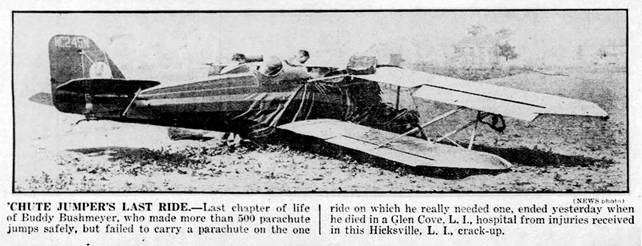
|
|
His
head hanging forward, the dying pilot sits in his cockpit.
New York
Daily, News June 6, 1930
|
|
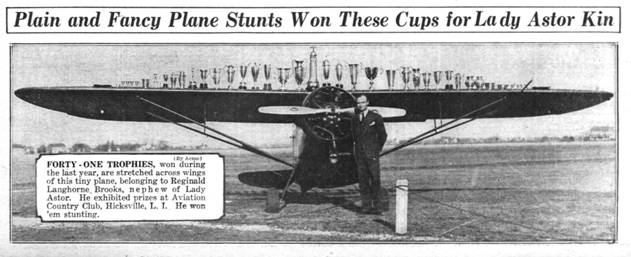
|
|
New
York
Daily News, December 31, 1931
|
There were many ways in which people could die during
the nadir of the Depression. The
Daily News regularly focused
on three that were too commonplace.
Each day, it published year-to-date totals of New York City
deaths that had been attributed to automobile collisions, to improperly
distilled (and not only illegal, but also poisonous) alcohol, and to
gunfire.
|
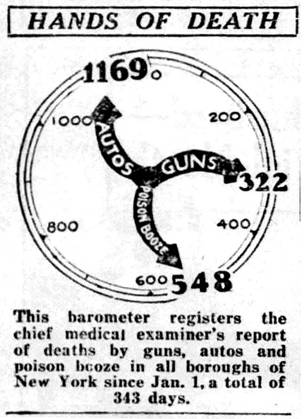
|
|
New
York
Daily News, December 10, 1929
|
|
*
|
Although
Hicksville
was not big, now and then its stories managed to push the City off the
front page, as each of these did:
|

|
|
The
body of Pretty Steve Sweeney, a victim of his own gang,
lies dumped on the grounds of the Aviation Country Club.
New York
Daily News, December 22, 1930
|
|
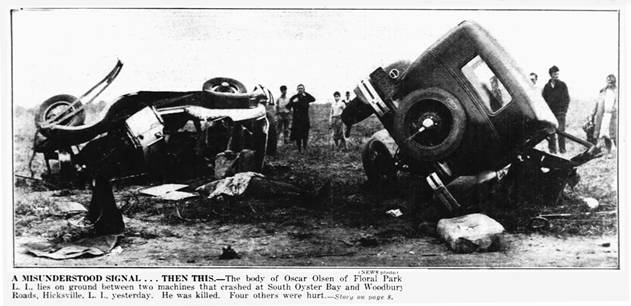
|
|
Presumably,
photographers all over
Long Island
kept one ear
open for nearby sirens, so that they could photograph mishaps
before the bodies were removed, and send the film to the News.
New York
Daily News, October 17, 1932
|
|
***
|
|
II
The
Dismal Texture of the Depression
|
The Great Depression ate away the flimsy glitz of the
1920s, and left grim despair
in its wake. Let's try to
imagine how it felt to live amid that despair.
Obviously, unemployment was a problem, and the basic statistics are
overwhelming. National
unemployment peaked at an incredible 25%, and though it began to drop,
it would remain above normal for more than a decade.
In 1930,
New York City
was home to 7,000,000 people, and its unemployed numbered 1,000,000.
My very rough and unverifiable calculations based on these
figures suggest that 2,500,000 NYC households had no income, or only a
diminished income, due to unemployment.
People who had relied on non-employment income (pensions, stock
dividends, rental properties, proceeds from owning businesses, etc.)
also suffered. At the outset
of the Depression, both the dividend income and the asset value of many
stocks simply evaporated. Consumers
(happily debt-ridden and dependent on constant easy credit throughout
the 1920s) all had to curtail their expenditures at once.
Because almost everybody stopped buying things, businesses
failed, pensions dried up, rent and mortgage payments disappeared.
Banks failed - with no money being deposited, they ran out of
funds with which to pay the withdrawals that everyone was making from
their savings accounts.
Many people were forced to sell whatever hard assets they had.
With so few people able to buy what they offered, however, sales
of valuable jewels, cars, and real estate returned only "pennies on
the dollar." Many lost
their homes and were forced to move in with relatives.
Others began to live as the homeless always have, squatting in
empty buildings, or in makeshift shacks.
The 1930s became the decade of the hobo, as men without jobs
tried adopting a nomadic lifestyle, riding freight trains in search of
work and handouts.
|
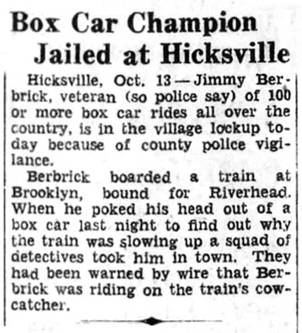
|
|
Evidently,
it was possible for a man
to become a celebrated hobo.
Brooklyn
Daily Eagle, October 13, 1932
|
As might be expected, the nation's suicide rate
doubled, spiking sharply to an all-time high.
It would not return to normal levels until the end of World War
II. Note that the official
statistics do not tell the entire story, for they omit failed suicide
attempts, or intentional deaths disguised as accidents or misadventure.
|
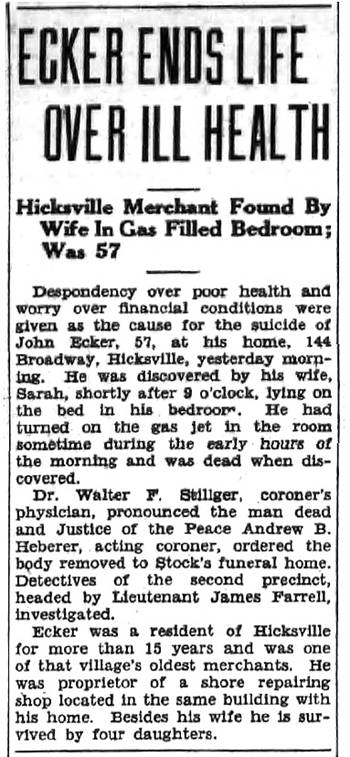
|
|
Nassau
Review Star, July 10, 1934
|
|
*
|
The word "starvation" is rarely used when a
qualified doctor records the cause of someone's death.
Instead, a specific life-ending medical condition (e.g., heart
failure) is recorded as the cause. In
fact, those who de facto
starve to death die from any number of official causes, including
infections and conditions which arise because of severe malnutrition.
Thus, it impossible to know accurately from official records how
many Americans died of starvation during the Depression.
The picture is also complicated by the likelihood that people who became
convinced of their impending starvation may have chosen to end their
lives without waiting for the final suffering, and thus are considered
as suicides, not victims of starvation.
And finally, there also is a probability that, in a severe state
of starvation, a person may accidentally fall or otherwise sustain fatal
trauma.
Whatever the numbers don't say, people did go hungry in these years,
and some of them died for want of food.
|
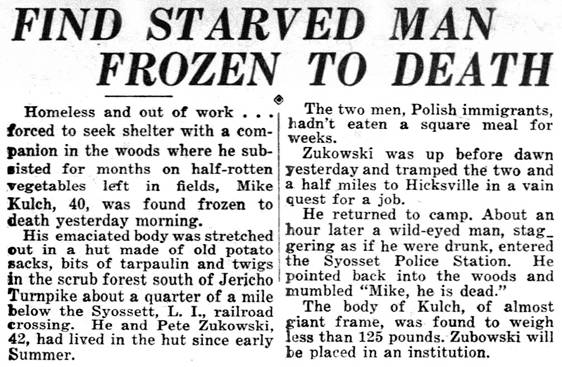
|
|
New York
Daily News, December 8, 1931
|
By 1932, communities all over the country were
responding, working with charities, clerics, and the Federal government
to distribute what they could to keep people alive.
|
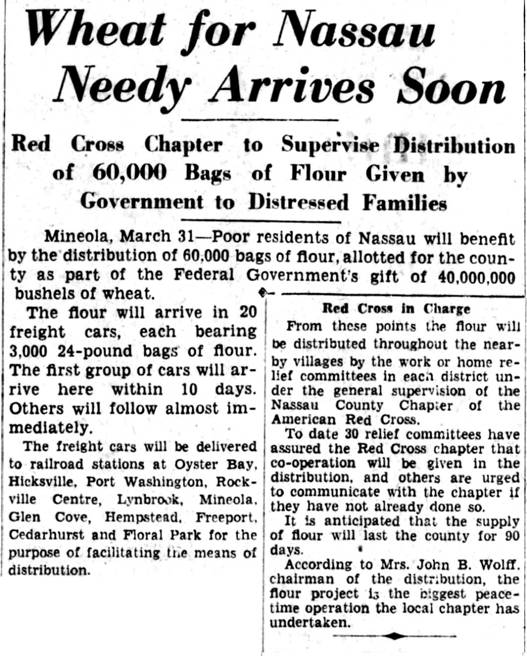
|
|
Brooklyn
Daily Eagle, March 31, 1932
|
|
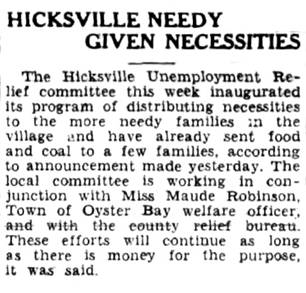
|
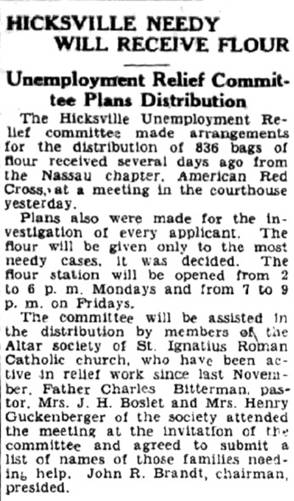
|
|
Nassau
Daily Review, March 15, 1932
|
Nassau
Daily Review, April 22, 1932
|
|
***
|
|
III
Crime
|
Most people would think that the crime rate increased
significantly during the Depression.
It did not.
Although there is a correlation between crime and economic hardship,
especially when the latter is measured in terms of unemployment, it is
not a question of simple arithmetic.
The precise relationship is not universal.
It differs from country to country, and even in a given country,
it is different in different eras. Sometimes,
similar changes in employment have had opposite effects on crime rate.
Violent, brazen murder was nothing new; the crime wars
of Prohibition had started long before the Great Depression.
What was new was where
the battles occurred. Crime,
like water, flows along the routes of least resistance.
It may move from city to city, or from city to suburb, rising in
some locales and receding in others, as new opportunities and
impediments arise. If, in a
given town, almost nobody has any cash to steal, random muggings will
soon stop. If the local
factory shuts down, there is no payroll to rob.
There are other factors, too. Some
sociologists hypothesize that people in need feel less desperate when
they live cooperatively under the same roof as their extended family,
and benefit from emotional support.
Whatever the reason(s), the national crime rate
remained flat - which is another way of saying that during the
Depression there was as much crime around as ever.
There were some new developments.
Economic hardship did lead to new "amateur criminals" setting
up stills in their basements or garages (a fact which helps explain why
so many people died from "poison booze").
The
Hicksville
octogenarians named below were likely in this category.
|
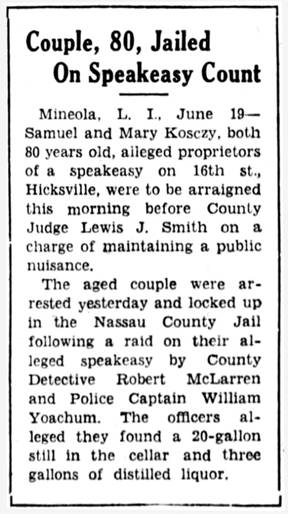
|
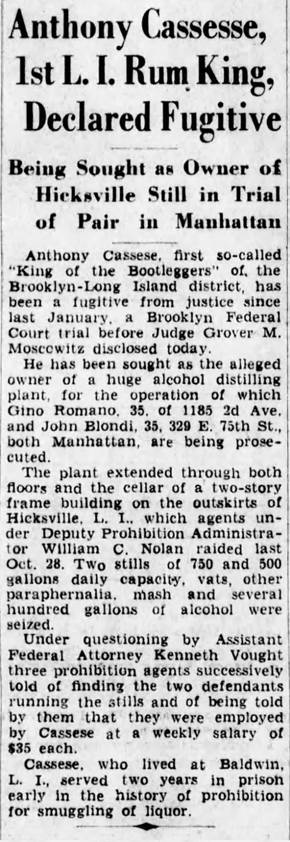
|
|
Brooklyn
Daily Eagle, June 20, 1929
|
Brooklyn
Daily Eagle, April 20, 1932
|
Many
amateurs may have decided that they were not sufficiently desperate to
dabble in other crimes, such as prostitution or armed robbery.
Of course, one cannot tell from the news items below if the
people involved were professional criminals or needy amateurs.
|
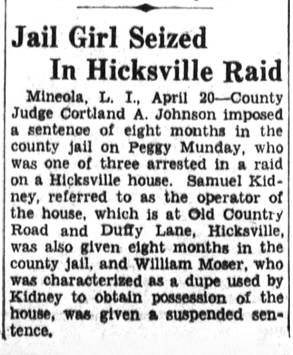
|
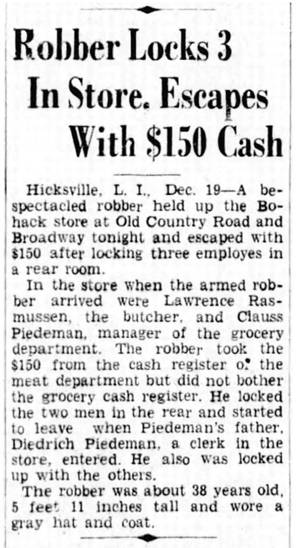
|
|
Brooklyn
Daily Eagle, March 8, 1932
|
Brooklyn
Daily Eagle, December 19, 1931
|
|
*
|
Long Islanders, even those who patronized speakeasies,
grew worried about an incursion of gangsters from the
Big
Bad
City
. Although criminals had
always traveled between, say, Brooklyn and
Hicksville
, improved cars and roads now made it easier.
Believing that the NYPD
had of late become better at
combating crime, the Nassau County Police felt obliged to prepare for a predicted
flood of fugitive City criminals. They
were ready to take action, even if that meant using machine guns to
safeguard the County line.
|

|
|
Brooklyn
Daily Eagle, August 29, 1931
|
|
***
|
|
IV
Crime
and Punishment,
but Hold the Justice, Please
|
Early
in August, 1932, some prominent citizens of Hicksville got together with
friends who lived elsewhere in the Town of Oyster Bay, and they
established a local chapter of an organization called the Nassau
County Police Protective Association.
Per its name, no ambiguity seems possible: a group with that name
must have been created so that its non-police members could band
together to protect the police who were protecting them.
What in the world was going on?
|

|
|
Brooklyn
Daily Eagle, August 7, 1932
|
I can't pretend to know the precise agenda the group
was pursuing, but the article above contains a couple of clues about why
it was formed. Some
policemen were going to be put on trial, and the Nassau County Police
Department's morale was allegedly suffering.
Before getting into the gist of the matter, I'll comment about the
latter point. The nation was
struggling to emerge from the worst point of the Depression, and about
20,000,000 desperate people were still unemployed.
If I had been one of them, and someone had asked me to do
something for, or donate money for, people who were employed but had a
morale problem, my reaction would have been blunt, vehement, and
definitely unprintable. What
about my morale, Bud?
All right, back to the facts.... What
was the Hyman Stark story, and why did it matter?
In mid-July, four men drove to an address in Roslyn,
knocked on the door, and rushed inside to rob the homeowner.
She was alone, and - contrary to their expectations - she had
no hoard of jewels and cash profits from speakeasies for them to take.
Intimidation did no good; the old (64) woman had nothing.
They left the home, and she reported the robbery attempt.
The next day, the press were told by the police that she lay in
Nassau
Hospital
, dying from having been pistol-whipped insensible.
Nassau Police had arrested the men, and had begun interrogating
Stark, their leader. Later
in the day, there was a second and hurried announcement: Hyman Stark had
confessed, and almost immediately afterwards, he had died without
warning.
It should be added that the hospitalized woman was the mother of a
County Police Detective.
|
*
|
|

|
|
New York
Daily News, July 16, 1932
|
The following day, the police said little.
The District Attorney announced that he was investigating the
police involved in the interrogation, and he hinted that he already had
incriminating evidence against some of them.
Meanwhile, the press had investigated further, and it had found
discrepancies between fact and the police statements.
According to physicians at the hospital, the woman had never been
pistol-whipped, had never been insensible, and - with no evidence of
injury - would have been released from the hospital had the police not
intervened. Hyman Stark, on
the other hand - having arrived at
Mineola
headquarters a healthy man in his early 20s - had been brought to the
hospital with fresh bruises all over his body, a severely bulging eye,
and a newly fractured larynx. He
had died from a cerebral
hemorrhage of "terrible" proportions, caused by his having been beaten about
the head.
The press also learned that Stark's interrogation had lasted for eight
solid hours, and that for part of the time, Stark lay on the floor,
while Deputy Chief Tappen (shown above), who weighed 300 pounds, had
rested his foot on Stark's throat.
All
these facts were known by the public when the District Attorney levied
manslaughter charges against Tanner and seven policemen, and assault
charges against five more. And
yet, the article about the new
Protective Association refers to Stark's death as accidental.
It also implies that the District Attorney's action, rather
than an unmerited and vicious beating by rogue policemen, is the cause
of the Department's declining morale.
Looking back almost a century, I don't know what to make of this
situation. With the facts
widely known, I don't understand why prominent and mostly
well-educated men would want to hinder the prosecution of renegade
policemen, who with forethought had perpetrated an unlawful killing -
but then, I've seen comparable things at other points in history.
|
***
|
|
V
Misplaced
Romanticism
|
It was hard to be upbeat without a job or money.
Your life had been derailed so badly that you couldn't even
find the right track, let alone get back on it.
Discouragement was inevitable, and it made things even worse.
People really needed "mental health breaks," distractions
that entertained and refreshed them.
If you had a radio at home, you knew that radio broadcasting was just
entering its Golden Age, and it was there for you - but radios were
expensive in the early 1930s. If
you couldn't afford adequate food, you were not about to buy a radio.
Movies were more affordable, if you went only once in a while,
but that was a sometimes thing. The
most affordable, and also the most abundant, font of diversion was the
daily newspaper. In terms of
entertainment, the newspaper was the Internet of the 1930s.
Reading it lifted you out of the dreariness of your daily
existence. The comics gave
you laughter. You could
choose to follow, day after day, the life and adventures of anyone you
met in the newspaper: a movie star, a socialite, a baseball player, a
comic strip hero - or just maybe, a criminal.
I'm not sure that anyone followed the day to day
exploits of, say, Legs Diamond, but many a small-time criminal's
arrest and trial grabbed the public's attention for weeks, or even
months. People were eager to
read the next day's exciting "episode," especially if the people
accused were young - older readers already were very worried about how
their own children or grandchildren were going to survive the
Depression.
Following the latest attention-getting crime, reporters would quickly
focus on one or two of those involved (if possible, young, attractive,
and female). They would
collect biographical information by interviewing friends and relatives,
and use what they learned to stoke public interest until a trial began
- at that point, the trial would supply new material to report, and
perhaps a nice conclusion. For
many readers, reading a continuing series of articles about a crime was
like watching a soap opera.
|
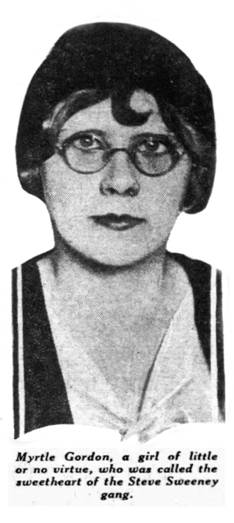
|
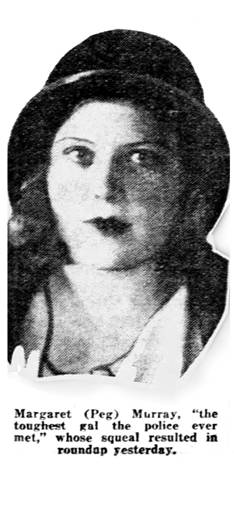
|
|
New
York
Daily News,
March 22, 1931
|
New
York
Daily News,
January 12, 1931
|
Thus, when the bloodied remains of Pretty Steve Sweeney
appeared on the front page - we looked at that picture earlier -
although his life had just ended, his story had just begun.
From that day forward, readers would be treated to whatever the Daily
News could scrounge up. They
learned that his gang had committed approximately 500 armed robberies of
speakeasies in the greater
New York
area, pulling in an estimated $100,000.
They read that the gang members were young, some of them under
20. Many of them had taken
direction not from Sweeney, but from Peg, his gun moll, 17 years old,
who - despite living with Pretty Steve - was a virgin (the doctor
who examined her at the jail was happy to confirm that fact for the
newspaper's readers). The
moll's mother lamented to a reporter that it was tough being an
impoverished mother in Hell's Kitchen, but that Peg was still a good
girl, who often attended Sunday Mass after a full Saturday night of
stick-ups.
One thinks of the grandparents who read her sorry tale, dabbing away
their tears, and thanking God that their own families were not like
hers.
|
***
|
|
Is
there a Conclusion?
|
Well, there's no profound one.
Let's just say that during the Depression, some people tried to
help each other, some tried to prey on each other, and some people
probably did both. It was a
remarkably gruesome time to endure.
The material at this
educational link
provides an excellent and concise narrative of how the
Depression changed
America
, forcing a great many working class people into a dehumanizing survival
mode.
OK, this one's over.
I wonder what I'll write about next month....
|





















